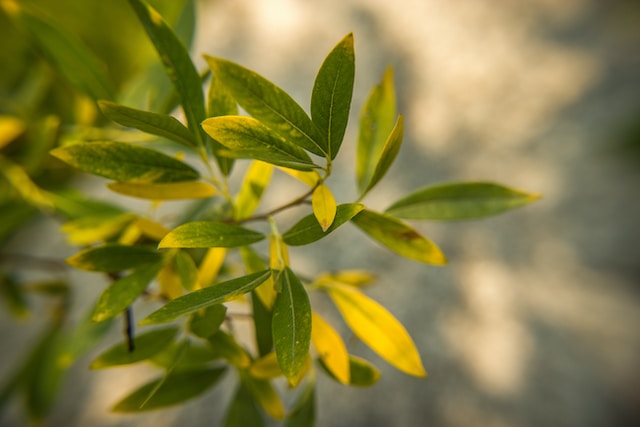Plant aficionados may find it disturbing when indoor plants begin to turn yellow. Yellow leaves often indicate a problem with the health of the plant. It's important to take into account a number of potential contributing elements in order to identify the issue and choose a suitable remedy for the discoloration. We'll talk about the typical causes of indoor plant yellowing in this session and provide workable fixes.
1. Overwatering or underwatering: Improper watering is one of the most frequent causes of yellowing indoor plants. Yellow leaves may result from both overwatering and underwatering.
Overwatering: Plants that get too much water may suffocate in their roots, which may cause root rot and fading foliage. The roots can't absorb vital nutrients because of the increased wetness.
Solution: Let the ground dry out in between applications of water. Water the plant just when the top inch of soil seems dry to the touch, and make sure the container has drainage holes.
Underwatering: A lack of water may also make leaves dry up and become yellow. Plants get discolored when they are unable to carry out photosynthesis efficiently due to a lack of water.
Solution: When the soil starts to dry up, give the plant plenty of water. Maintain a regular watering schedule and make adjustments according to the particular needs of the plant.
2. Poor Drainage: To avoid soggy roots, indoor plants need soil that drains properly. Without drainage holes, water collects at the bottom of the container, rotting the roots and turning the leaves yellow.
Solution: To guarantee enough aeration and drainage for the roots, repot the plant into a container with drainage holes and use potting mix that drains effectively.
3. Inadequate Light: Indoor plants that get too little or too much light may develop fading leaves. Because different plants need different amounts of light, it may be stressful to place a plant in an unsuitable environment.
Low Light: When put in a low-light setting, plants that need strong, indirect light may become yellow.
Solution: To achieve the required amount of light intensity, move the plant to a spot with more indirect sunlight or think about utilizing artificial grow lights.
High Light: On the other side, certain plants may burn from prolonged exposure to direct sunlight, which causes the leaves to become brown and yellow.
Solution: To avoid sunburn, move the plant to an area with filtered or indirect sunlight. It might also be beneficial to provide shade during the hottest times of the day.
4. Nutrient Deficiency: Yellowing leaves may be an indication of a nutrient deficiency, such as one in nitrogen, iron, or magnesium. Every nutritional deficit shows up on the leaves in a different manner.
Older leaves that are nitrogen-deficient often develop a light yellow color.
Solution: To restore the plant's nutritional levels, fertilize it with a balanced fertilizer that is high in nitrogen.
Iron shortage: Young leaves with an iron shortage will have yellowing between the veins.
Solution: To correct the deficit, use iron chelate supplements or use a fertilizer that has been fortified with iron. To improve iron absorption, make sure the pH of the soil is within the proper range.
5. Pests and infections: Yellowing and wilting leaves might be a sign of fungal infections, spider mite infestations, or aphid infestations.
Pests: By sucking the sap from plant leaves, insects such as spider mites cause yellow patches and webbing.
Solution: To get rid of the pests, treat the plant with neem oil or insecticidal soap. Examine the plant often to identify pests early.
Diseases: Bacterial or fungal diseases may cause yellow patches or spots on leaves, which can also cause withering and general health problems.
The best course of action is to remove the afflicted plant portions and stop the illness from spreading by using an appropriate fungicide or bactericide.
6. Environmental Stress: Variations in temperature and airflow may cause indoor plants to become sensitive to environmental changes.
Temperature Stress: Unexpected temperature changes, particularly those resulting from cold drafts, may cause leaves to turn yellow and fall.
Solution: Keep the space at a constant temperature and keep the plant away from drafty places. Keep plants away from air conditioners and heaters.
7. Root Bound: Yellow leaves result from a plant's roots being congested as it outgrows its container.
Repot the plant in a bigger container to give its roots more room to spread out. When repotting, carefully loosen the roots to promote strong growth.
8. Chemical Exposure: Indoor plants may suffer yellowing of the foliage due to chemical vapors from paints, cleaning chemicals, and smoking.
Solution: Plants should not be near locations that smell strongly of chemicals. Make sure the inside area has enough ventilation to release any dangerous vapors.
In conclusion, there are a number of reasons why indoor plants get yellow, such as overwatering, improper drainage, insufficient light, nutritional shortages, pests, illnesses, environmental stress, root problems, and chemical exposure. Finding the precise reason for the fading leaves is essential to taking successful action. Careful observation, appropriate watering techniques, providing enough light, performing routine insect checks, and maintaining a clean environment can all help to keep your indoor plants bright and green. Keep in mind that every type of plant has specific demands; therefore, knowing what your plant requires is essential to its general health.
